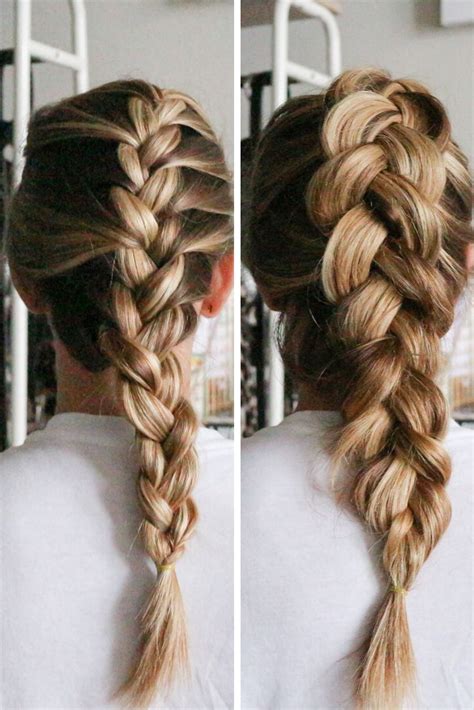Introduction
When it comes to hair braiding, French and Dutch braids are two of the most iconic styles. Both are versatile, stylish, and relatively easy to learn, making them perfect for any occasion. But which one is right for you? Let’s compare the two braids and see which one comes out on top.

French Braid
What is a French Braid?
A French braid is a three-strand braid that starts at the crown of the head and gradually adds hair from the sides as it is braided down the back. This results in a raised, intricate braid that looks more complex than it actually is.
Pros of French Braids
- Versatile: French braids can be worn in a variety of styles, from buns to ponytails to fishtails.
- Easy to learn: With a little practice, anyone can master the French braid.
- Elegant: French braids are a classic, sophisticated hairstyle that is perfect for any occasion.
- Hides imperfections: A French braid can help to hide overgrown roots or hair that is not freshly washed.
Cons of French Braids
- Time-consuming: French braids can take longer to create than other types of braids.
- Not ideal for short hair: French braids require a certain amount of length to work well.
- Can be bulky: French braids can be quite bulky, which may not be ideal for some people.
Dutch Braid
What is a Dutch Braid?
A Dutch braid is also known as an inside-out French braid. Similar to a French braid, it starts at the crown of the head and incorporates hair from the sides. However, the difference lies in the way the strands are crossed. In a Dutch braid, the strands are crossed under instead of over, resulting in a raised, more voluminous braid.
Pros of Dutch Braids
- Voluminous: Dutch braids are known for their volume, making them a great choice for people with fine or thin hair.
- Secure: Dutch braids are very secure and can withstand even the most active activities.
- Unique: The inverted crossing of the strands gives Dutch braids a unique and eye-catching look.
- Easy to maintain: Once complete, Dutch braids can last for several days with minimal maintenance.
Cons of Dutch Braids
- Can be difficult to master: Dutch braids require a bit more skill to create than French braids.
- Can look messy: If not done correctly, Dutch braids can appear messy or uneven.
- Can be uncomfortable: The tension created when crossing the strands under can be uncomfortable for some people.
Which Braid is Right for You?
The choice between a French braid and a Dutch braid ultimately depends on your personal preferences and hair type. If you are looking for a versatile, elegant braid that is easy to learn, a French braid is a great option. If you want a voluminous, secure braid that will hold up under any activity, a Dutch braid is a better choice.
Conclusion
Both French braids and Dutch braids are beautiful and versatile hairstyles that can be worn in a variety of ways. Ultimately, the best way to choose between the two is to try both and see which one you prefer. With a little practice, you’ll be able to master both braids and add a touch of style to any outfit.
Additional Tips and Tricks
- Use a mirror: Braiding your hair can be easier if you use a mirror to see what you are doing.
- Start with small sections: When you are first starting out, it is helpful to start with small sections of hair and gradually increase the size as you get more comfortable.
- Practice makes perfect: Don’t get discouraged if your first few braids are not perfect. With practice, you will be able to create beautiful braids in no time.
- Add accessories: Braids can be dressed up or down with a variety of accessories, such as hair clips, ribbons, or flowers.
FAQs
1. How long does it take to master a French braid?
With a little practice, most people can master a French braid within a few weeks.
2. Can I braid my hair if it is short?
French and Dutch braids can be challenging to create with short hair, but it is not impossible. If your hair is short, you can try using smaller sections or braiding only the top part of your hair.
3. How often should I wash my hair before braiding it?
For the best results, wash your hair 1-2 days before braiding it. This will give your hair enough time to dry completely and become more manageable.
4. How can I make my braids last longer?
To make your braids last longer, apply a small amount of hairspray or mousse before braiding. You can also try sleeping on a silk pillowcase to reduce friction and prevent your hair from tangling.
5. Can I braid my hair after coloring it?
It is best to wait 2-3 days after coloring your hair before braiding it. This will give your hair time to adjust to the new color and reduce the risk of breakage.
6. How do I remove a braid without tangling my hair?
To remove a braid without tangling your hair, start by gently pulling apart the bottom section of the braid. Continue working your way up the braid, gradually loosening the strands until the entire braid is removed.
